Barring mechanical contact between the spark plug and piston, just about any randomly selected spark plug will ignite the gasoline and air compressed into an engine’s combustion chamber. Very few spark plugs, however, will continue to perform well under a wide range of engine temperatures, loads and speeds, not to mention lasting well beyond today’s standard replacement interval of 100,000 miles.
At least four conditions are required for maximum spark plug life. First, the engine management system must mix a chemically perfect or “stoichiometric” ratio of 14.7 units of air to 1 unit of fuel.
Second, the combustion event must be perfectly timed to achieve a smooth “burn” in the cylinder.
Third, the valve guides, seals, pistons and piston rings must be in good condition to prevent engine oil from entering the combustion chamber.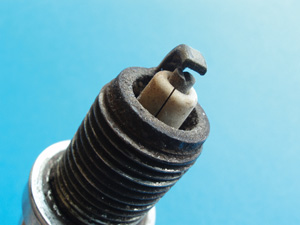
Fourth, the spark plug must be correctly torqued and seated to the cylinder head to help dissipate excess heat from the electrodes. If all of the above conditions are present, the spark plug will have an “out-of-the-box” appearance (See Photo 1).
Most spark plugs are designed to maintain an operating temperature of 900° F and 1,500° F at the center insulator. If the insulator temperature drops below 900° F, accumulated carbon causes a cylinder misfire by shorting the spark to ground. During normal driving, the insulator temperature rarely exceeds either temperature extreme and therefore delivers maximum spark plug life. However, as the insulator approaches 1,500° F during wide-open-throttle (WOT) operation, the spark plug electrodes erode until the increased air gap demands more electrical energy than the ignition system can produce to create a spark (See Photo 2).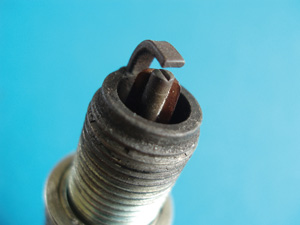
Pre-ignition and Detonation
Although pre-ignition and detonation are rarely encountered on late-model engine management systems, engine damage can occur if the EGR or detonation sensor system has been disabled, the base ignition timing is incorrectly adjusted or an incorrect spark plug heat range is installed.
To illustrate, when the center electrode exceeds 1,500° F temperature, the red-hot electrode will ignite the air/fuel mixture long before the timed spark event takes place. Because pre-ignition exposes the piston to a long-burn event, the center of the piston overheats and will eventually melt. A spark plug exposed to pre-ignition will typically have a salt-and-pepper look, which is caused by bits of melted aluminum sticking to the inner insulator. Pre-ignition is generally caused by over-advanced spark timing or by the heat range of the spark plugs being too hot (See Photo 3).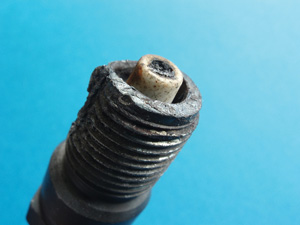
Detonation, on the other hand, is typified by a knocking or rattling sound coming from the engine, which is caused by the nearly simultaneous ignition of the air/fuel mixture at two or more points in the cylinder. Detonation is most often indicated by chipping on the center electrode insulator or breakage of the ring land at the edge of the piston. Although detonation is usually caused by the gasoline’s octane rating not meeting the compression ratio requirements of the engine, detonation can also be caused by an inoperative EGR valve system (See Photo 4). On rare occasions, a longitudinal crack in the center electrode insulator can be caused by a leaking cylinder head gasket allowing coolant to strike the hot insulator (See Photo 5). This should not be confused with damage caused by a detonation condition.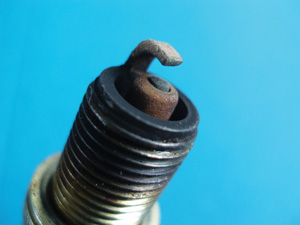
Showing Their Colors
Although reading spark plugs is as much of an art as it is a science, a rule of thumb says that if the air/fuel mixture is too lean, the inner shell and insulator will look box-clean and the ground electrode will show a blue coloration.
If the air/fuel ratio is operating slightly rich, the inner insulator should show a light tan or grey color, while the ground electrode and inner shell should also show a darker tan or grey color.
If the air/fuel ratio is too rich, the insulator and electrodes will be lightly coated with soot.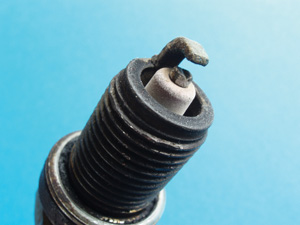
Watch The Gap
In essence, a wide electrode air gap will increase burn efficiency on conventional production engines. In racing applications, the air gap is often narrowed to increase the ignitability of the air/fuel mixture at high cylinder pressures and engine speeds.
Always remember that increased air gaps require increased firing voltages that may exceed the capacity of the ignition coil to fire the mixture or the ability of the secondary ignition to contain the spark. Remember, too, that decreased gaps slightly advance spark timing while increased gaps slightly retard timing.
Installation Tips
Because late-model ignition systems are typically producing in excess of 60,000 volts, spark plug wires should be handled carefully to prevent tearing or perforation. Since high-voltage wire insulation eventually develops microscopic perforations and open-circuit conductors, most wires should be replaced at the OE-specified interval or at 100,000-mile intervals.
Several rules should be followed when replacing spark plugs. First, allow aluminum cylinder heads to cool before removing the spark plugs. If a spark plug is seized, soak it with penetrating oil and alternately tighten and loosen the plug until it rotates freely.
Next, always torque the spark plugs to specification. Loose spark plugs can cause pre-ignition or can seize in the cylinder head, and over-tightened spark plugs can cause gas leakage between the shell seal and insulator and damage to the threads in the cylinder head.
To prevent greasy fingers from contaminating spark plug insulators, insert the new spark plug into a length of fuel hose for gapping and installation. When adjusting a spark plug’s air gap, avoid inadvertently scraping the precious metal plating from the electrodes.











